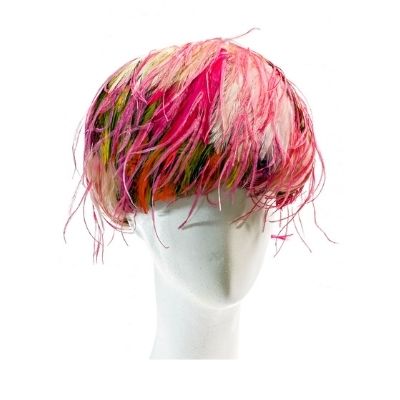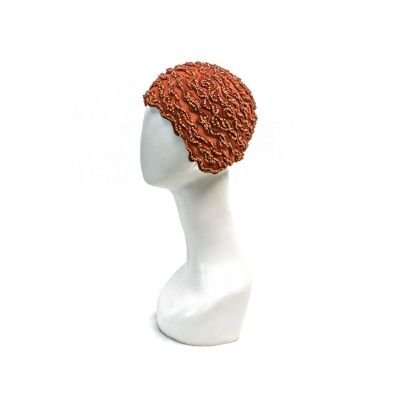The Milliner's Tale


The Craft of Hat Making
The Milliner’s Tale: The Craft of Hat Making ran from January 17 to June 29th, 2016. This exhibit examined the changing landscape of the millinery trade over the last two centuries from the perspective of the milliner as a craftsperson.
Beginning in the late 18th century, the millinery trade, along with dressmaking and other sewing industries, provided women with an acceptable occupation at a time when few women worked outside the home. In fact women were awarded patents in relation to millinery. In 1716, inventor and milliner Sybilla Righton Masters (d. 1720) of Burlington Township was awarded a patent related to a method of working straw for hats and bonnets. By the mid-19th century, women began to take their place as shopkeepers and business owners who could make their own way in the world.
The exhibit examined the “inner workings” of the hats and illustrates the techniques used to make them, the historical eras that produced them, and what they can tell us about the personalities of the milliner and the wearer.
Also displayed were some of the tools of the trade from the collection of the Museum of Early Trades & Crafts, and related crafts such as artificial flowers, materials, and trimmings that made each hat a distinct work of art. The tradition of handmade millinery continues to this day, taking up the higher end of the hat making market.
The hats featured in this exhibit site are only a few examples of the hats in the exhibit. We also included select modern pieces created by 21st century milliners – evidence that millinery is a craft still very much alive.
For this exhibit, METC collaborated closely with Ms.Stebbins, the Morris Museum, and the Morris County Historical Society/Acorn Hall to include a collection of historically important hats and ephemera. METC members and friends also provided vintage and antique boxes, also an important part of the millinery trade. The stunning collection of hats in the exhibit show the outer beauty and the complicated techniques used to make them. Visitors were taken through the historical eras of the millinery trade and cultural aspects of hat wearing and how one hat can speak volumes about the milliner and the hat wearer.
Milliner and Assistant Curator Monika Stebbins

Award-winning milliner, guest curator, and Madison resident, Monika Stebbins, worked closely with METC staff to create an exhibit that examines the millinery trade from the 18th-20th century perspective of the milliner as a craftsperson.A feature of this exhibit was an on-site millinery studio, where Ms. Stebbins demonstrated parts of the hat making process for guests.
On the exhibit, Ms. Stebbins stated, “In keeping with METC’s mission, this exhibit focuses on the making of hats, and on the milliners who made them. Even without detailed provenance, we can look at a hat and determine whether the milliner was meticulous, sloppy, patient, or lazy; whether she was a master of the craft or bungled her way to the finished hat. Equally, the hat tells us what kind of woman wore it: self-confident or shy, fashion-forward or demure. Studying and analyzing these hats from the collection of the Morris Museum and Morris County Historical Society/Acorn Hall has been a rare opportunity and pure pleasure for me.”
Deborah Farrar Starker, METC’s Executive Director commented, “collaborating with Monika has been extremely enjoyable. Her breadth of knowledge about the history of millinery and her expertise were invaluable throughout the entire process.”
Objects on Display
The Town Milliner (1780-1880)
In early American history, most towns had at least one milliner, who custom-made hats for the women in her town. The hats in this section of this exhibit were handmade in the early 1800s.
Calash Bonnet,c. 1780
Collection of the Morris County Historical Society/Acorn Hall
This exquisite silk bonnet is over 200 years old. Its olive green silk and ribbon are still miraculously intact, although the color has faded to a light brown. The word calash comes from the French word for the top of a carriage. The spines that give the hat its signature carriage-top appearance are made from round cane or rattan, which the milliner soaked to make pliable before they were shaped and dried.
Purple Travel Bonnet, Early 1800s
Collection of The Morris Museum
This stunning silk bonnet was made to fit around the large hairstyles of its time. The milliner quilted the salmon liner, which peeks out from under the brim. This quilting made the bonnet cozy, warm, and perfect for travel. It features two drawstrings, including one around the back bun and one near the face, both for fitting the bonnet snugly over the period’s large hairstyles. The owner could wrap herself in this large bonnet to protect against the weather. The purple, teal, and cream silk is in remarkable condition given its age.
Cotton Bonnet, 1800s
Collection of The Morris Museum
This bonnet was made for a child. The white cotton bonnet is beautifully hand sewn and embroidered with an intricate arabesque pattern. The two ties secure the bonnet underneath the wearer’s chin and also add a decorative element. It is trimmed with a strip of handmade lace and includes a ruffle in the neck, also beautifully embroidered. It is very rare to find a piece of embroidery from this time period in such pristine condition. Bonnets in this style still exist for baptisms and other special occasions.
The Ready to Wear Revolution (1880-1960)
Straw Hat – “Shepherdess”, Late 1800s
Collection of the Morris County Historical Society/Acorn Hall
The late nineteenth century gave us many fine examples of intricate straw work, which this hat represents beautifully. One part of this hat is not like the other. In fact, the straw hat and its signature red ribbon trim come from two different eras. A nineteenth century milliner made the straw base with its fine horsehair braids, scalloped brim, and tiny straw flowers. A less-skilled trimmer added the velvet bow and colorful flowers much later. Their bright colors have faded over time. Customers often asked milliners to add flowers and bows to older hats.
Turban with Pin, “R.H. Macy & Co.”, c. 1910
Collection of The Morris Museum
By the early twentieth century, department stores like Macy’s employed milliners. This pink turban with a purple pin bears the “R.H. Macy & Co. – Chapeaux de Grand Chic” label. Inside folds reveal the original cherry red color of the silk velvet, faded now to a light pink. Chevrons drape the front of the hat, running from left to right. The hat’s maker made the crown and the drape from one big piece using machine-made seams. Milliners adopted the sewing machine in the late 1800s for simpler stitches.
Pink and Black “Caspar Davis” Hat, c. 1940
Collection of Morris Museum
Caspar Davis, a male Hollywood milliner who designed headwear for the stars, designed this smart pink hat for national department stores. It was made with velour, fur, felt, and velvet, with an egret plume inserted into the felt and secured on the inside. The brim’s edge is turned under and finished with grosgrain piping. The crown was hand-draped over a block rather than the older wire frame technique. Men began to design and trim hats for national women’s clothing lines during this period, filling niches once occupied exclusively by women.
From Social Necessity to Fashion Accessory (1960 to Present)
Swiss Braid Hat, “Beverly Shoppe”, c.1960
Collection of The Morris Museum
The Beverly Millinery Shoppe, run by Jessie Weinstein and her husband Samuel, served Plainfield, New Jersey, from 1925-1968. A Swiss braid in a caramel and yellow color sewn in rounds forms the base of this hat. This piece also sports a caramel grosgrain ribbon made with one large loop rolled up in the middle. This is a fine example of a millinery shop piece from an era when these shops graced many Main Streets across the country, including many small towns in New Jersey.
Pink Feather Hat – Christian Dior, c.1960s
Collection of The Morris Museum
Christian Dior designed this line of hats for Jordan Marsh in the 1960s. The designer generously covered the entire hat with ostrich, rooster, and guinea feathers in “psychedelic” yellows, pinks, oranges, olives, and blues. The understructure is capenet, a special construction material. Multi-colored gems cover the feathers, which are glued onto the canvas and look like tiny coils. Women in this era bought unique hats like these to express their identity and make a fashion statement—just like women for generations before and after them.
Flower Pillbox Hat – AMY Label, c.1960
Collection of The Morris Museum
A milliner designed this hat in layers, most invisible on the outside. The casual observer sees only the sheer flowers and leaves in pale pinks and greens in a careful arrangement. A printed chiffon material in red, green yellow, orange, and purple lies just underneath the flowers, followed by an under form made from a coarse knit material. This layer is lined with lace. The label reveals that the hat belongs to the AMY line of hats in New York established by Frances Kleinfeld and her husband, Walter Nelkin.
Something Special: Modern Day Millinery
Beaded Cloche, Contemporary/21st Century
Milliner: Cigmond
The wavy beaded patterns in this velour cloche remind the viewer of rolling desert dunes. The hat is made from two layers of felt. The milliner used the overblocking method to make this hat: first, she blocked and dried the felt and then she blocked and dried the second layer of felt over the first layer. The design is drawn on the second layer of felt. The waves are cut from the second layer and then beaded with tiny brown and pink beads.
Leather Cloche, Contemporary/21st Century
Milliner: Hats by Kat and Accessories Too
Compare this modern cloche to the brown aviator-style cloche from the 1920s, which appears earlier in this exhibit. This cloche was constructed on a felt base and then covered in a patchwork technique with a variety of leathers and suedes. The larger stitches that outline the patchwork leather pieces are decorative running stitches, and the smaller stitches are machine-made top stitches. Additionally, the hat is trimmed with leather fringe and buttons. The asymmetrical partial brim gives this piece a unique look.
“Finch” – Velour Fur Felt Hat, Contemporary/21st Century
Milliner: Eggcup Designs
This adorable hat has a friend: the little finch perched on the crown. This medium-sized hat is constructed from velour fur felt. After blocking the hat, the milliner “painted” the surface with an intricate top stitch pattern in pink, white, and light and dark gray, which is visible in arches on the crown and around the brim. It includes a single black grosgrain ribbon around the crown and is finished with a charming applique finch cut from felt with a beaded eye and feathers.
Hats Off to Those Who Made this Exhibit Possible
- The Morris Museum
- The Morris County Historical Society/Acorn Hall
- Whole Foods
- Art Work
- Bette Blank
Photography
- Tom Judd
Hat Donors
- Cigmond
- Eggcup Designs
- Hats by Kat and Accessories Too
- Hat Box Donors
- Kathy Haines
- Elizabeth Holdsworth













